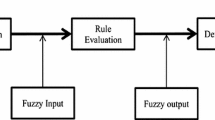Abstract
Since 1950s the techniques of Operations Research (OR) and Optimization have been utilized to increase the efficiency of the production systems. With the widespread use of computers, it has even become easier to deal with industrial problems. However the complexity of the problems still reveals the difficulty in providing solutions. The use of artificial intelligence (AI) seems to attract the attention of the researcher to overcome to the difficulties. This has already been realized with several successful applications. In this study, the use of AI and OR techniques is compared using fuzzy logic. The progress of manufacturing systems, characteristics of production processes, system managements and system behavior are taken into account. The study is focussed on only discrete manufacturing.
Similar content being viewed by others
References
Banenji, R. B. (1980) Artificial Intelligence: A Theoretical Approach, North Holland, New York.
Bobrow, D. G. (1994) Artificial Intelligence in Perspective, MIT Press, Cambridge, MA.
Dietrich, B. L. (1991) A taxonomy of discrete manufacturing systems. Operations Research, 39(6), 886–902.
Freund, J. E. and Walpole, R. E. (1987) Mathematical Statistics, Prentice-Hall, Englewood Cliffs, NJ.
Fukunago, K. (1990) Introduction to Statistical Pattern Recognition, Academia Press, Boston.
Hillier, F. S. and Lieberman, G. J. (1995) Introduction to Operations Research, McGraw Hill.
Karayalcin, I. An Invited Paper, 6A. Education in OR Evaluation Of Progress in Operations Research Education in Europe in The Last Decade And Some Proposals. EURO III–The Third European Congress on Operations Research, Amsterdam, Netherlands, 9, 11 April, 1979.
Luger, G. F. and Stubblefield, W. A. (1998) Artificial Intelligence: Structures and Strategies for Complex Problem Solving, Harlow, England, Addison Wesley Longman, Reading, MA.
Luger, G. F. (1999) Artificial Intelligence, Addison Wesley Longman, Inc.
Matos, C. and Pita, H. (1995) Towards a taxonomy of CIM activities. International Journal of Computer Integrated Manufacturing, 8(3), 160–176.
Mendenhall, W. (1987) Introduction to Probability and Statistics, Duxbury Press, Boston.
Nilsson, N. J. (1998) Artificial Intelligence: A New Synthesis, Morgan Kaufmann Publishers, San Francisco, California.
Qiao, B. and Zhu, J. (2000) Agent-based intelligent manufacturing systems for the 21st century. International Forum for Graduates and Young Researchers of EYPO, Hannover, The World Exposition in German.
Rambold, Y., Nnaji, B. O. and Storr, A. (1993) Computer Integrated Manufacturing and Engineering, Addison-Wesley Publishing Company.
Ravindran, A., Philips, D. T. and Solberg, J. J. (1987) Operations Research: Principles and Practice, Wiley, New York.
Rich, E. and Knight, K. (1991) Artificial Intelligence, McGraw-Hill, New York.
Sanches, E. (1976) Resolution of composite fuzzy relation equations. Information and Control, 20, 38–48.
Schutzer, D. (1987) Artificial Intelligence: An Applications-Oriented Approach, Van Nostrand Reinhold, New York, www.sciencedrect.com.
Singh, N. (1996) System Approach to Computer-Integrated Design and Manufacturing, John Wiley and Sons Inc.
Taha, A. H. (1997) Operations Research, Prentice Hall.
Taskin, H. and Golec, A. (1996) Bir Imalat Kurulucsunda Bulanik Maktikla Bilgisayar Bütünlecsik Imalat Sistemlerinin Değerlendirilmesi. Proceeding of The First Turkish Symposium on Intelligent Manufacturing Systems, 30–31 May 1996, pp. 103–118.
Wackerly, D., Mendenhall, W. III and Scheaffer, R. L. (1996) Mathematical Statistics with Applications, Duxbury Press, Belmont.
Winston, P. H. (1992) Artificial Intelligence, Addison-Wesley Pub. Co.
Author information
Authors and Affiliations
Rights and permissions
About this article
Cite this article
Kubat, C., Taşkin, H., Topal, B. et al. Comparison of OR and AI methods in discrete manufacturing using fuzzy logic. Journal of Intelligent Manufacturing 15, 517–526 (2004). https://doi.org/10.1023/B:JIMS.0000034115.63358.7e
Issue Date:
DOI: https://doi.org/10.1023/B:JIMS.0000034115.63358.7e




